
Wednesday July 23, 2003
Scalextric NASCAR Front Guide Fix
 If there is a model that can be
classified as one of my favorites, the inline Scalextric NASCAR certainly is one
of them. Not only is the older 98-99 Taurus still available, the 2000-2002
Pontiacs are very similar in chassis design. As much fun as these models are,
there does seem to be one issue that seems to plague them all: The front guide
pops out too easily.
If there is a model that can be
classified as one of my favorites, the inline Scalextric NASCAR certainly is one
of them. Not only is the older 98-99 Taurus still available, the 2000-2002
Pontiacs are very similar in chassis design. As much fun as these models are,
there does seem to be one issue that seems to plague them all: The front guide
pops out too easily.
And to be more precise, it isn't really the guide that is the problem, it is the metal contact strips that Scalextric uses to transfer power from the rails to the motor. These contact strips are sometimes bent up too far and cause excess pressure on the guide, causing it to sometimes pop out of the mount in the event of a crash or even occurs with simply de-slotting. Sometimes it will not pop out all the way, but far enough to lose contact and cause erratic performance.
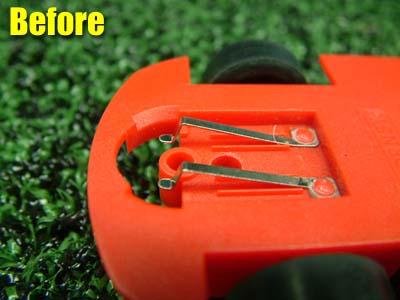
You might find that this issue is more common in the older versions of these models as they are equipped with a very weak bar magnet, and thus the car is less stuck to the track. However, I have had this happen on the newer cars equipped with the stronger Scalextric bar magnet as well, and this quick fix applies to both models.
My fixes are by no means the best way, rather solutions that do not require any major surgery to the chassis or soldering. The second fix does require one magnet, however given the fact it is still around $2.00, your investment is quite minimal. All you need for this first modification is a inexpensive bottle of Super Glue adhesive, and soon you will be back on the track with the issue of the guide popping out of the mount virtually non-existent.
First, remove the guide from its mount. Now you can see the contact strips and better understand the problem. You cannot really bend these back far enough by hand to help eliminate the problem, or at least I couldn't in my efforts. Next, take a flat tip screwdriver and push down on the contact strip as shown in the photo.
Now while the strip is seated flush with the chassis, take a small drop of glue and add it on bottom of the contact strip near the area where it connects to the chassis, the glue will flow underneath as well, securing this strip to the chassis. Do NOT flow glue near the top, as you might need to adjust this a little later on. You have now successfully cured this excess pressure, and more than likely you won't see the guide pop out so easily. Next, re-install the guide and make sure the strips are still in contact with the braid that wraps around the top of the guide. You can see that we only corrected it slightly, yet it does make a big difference.
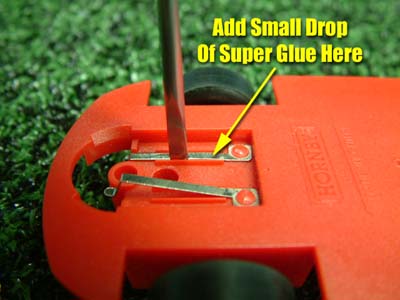
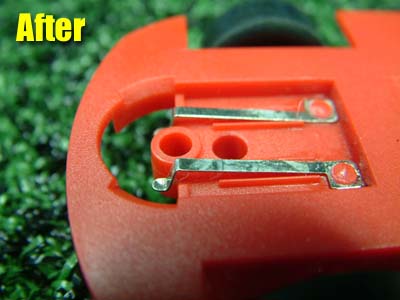
Now place the model on the track and test it. If you have intermittent power in places, it is most likely due to the fact the braid is not touching the contact strip fully. This is why you didn't want to glue the whole strip to the chassis. It is easily corrected by simply removing the front guide again and pulling up on the contact strip SLIGHTLY. Then re-install the guide and test it again. It is also a good idea to replace the guide with a new one if this problem has been happening a lot before you tried this modification.
Again, let me stress that this is just MY way of fixing this issue without the need for extra parts or heavy modification. If you like your models with a little magnet to them, and don't mind the small investment, you can purchase magnets to be placed near the front to further increase the down-force on the front guide, or what I like to call: "Pinning action". We use 1 Tweaker magnet placed as shown in the photo, and this helps pin the front end down nicely, without adding a lot of magnetic drag to the model.
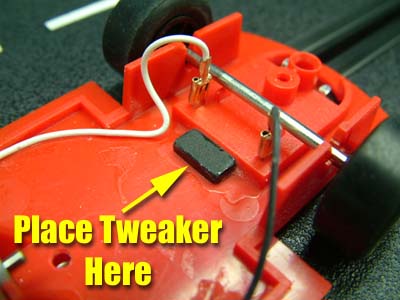
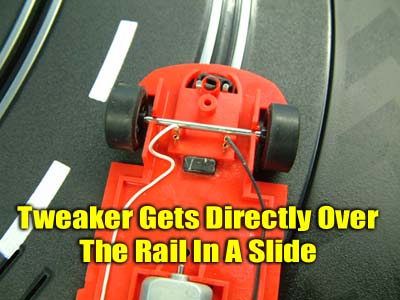
As you can see, the Tweaker isn't that wide with most of the magnet riding over the slot, except over Scalextric Sport where it does have a little more. Between this, and the distance from the rails it is relative too, attributes a great deal to why it doesn't cause as much magnetic drag to the model, especially in the straights where you don't want it. However, when you begin to slide in a turn this magnet floats over the rail and provides a good amount pinning action helping you stay in the slot.

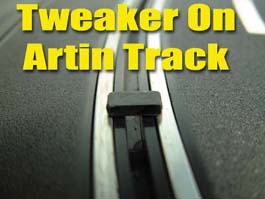

Now fans of non-magnet racing may not like this idea, and will want to use lead weight instead. I have tried this as well, however this seems to work perfectly and still forces you to actually DRIVE the car, especially since we are using the older magnet in the rear. Our new class of older NASCARS are a mix between lead and the Tweaker, and both are a very close match.
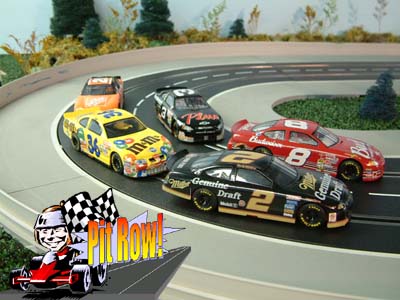 I
hope this helps some of you that are having this problem, and that it gets you
back on the track having fun! Almost every model released needs a little work
here and there to get them the way YOU want them to be, and that is what this
Pit Row section is dedicated to. If you have other ideas on how to cure this
issue, or other helpful tips, by all means send them in so we can help other
enthusiasts get more out of their hobby!
I
hope this helps some of you that are having this problem, and that it gets you
back on the track having fun! Almost every model released needs a little work
here and there to get them the way YOU want them to be, and that is what this
Pit Row section is dedicated to. If you have other ideas on how to cure this
issue, or other helpful tips, by all means send them in so we can help other
enthusiasts get more out of their hobby!
Harry
As always feel free to contact me about this article or just the hobby in general at wiseone@yhti.net, or better yet drop into our Message Forum and share your thoughts with other enthusiasts!
Make sure to check our PIT ROW Section often as we try to update it frequently!